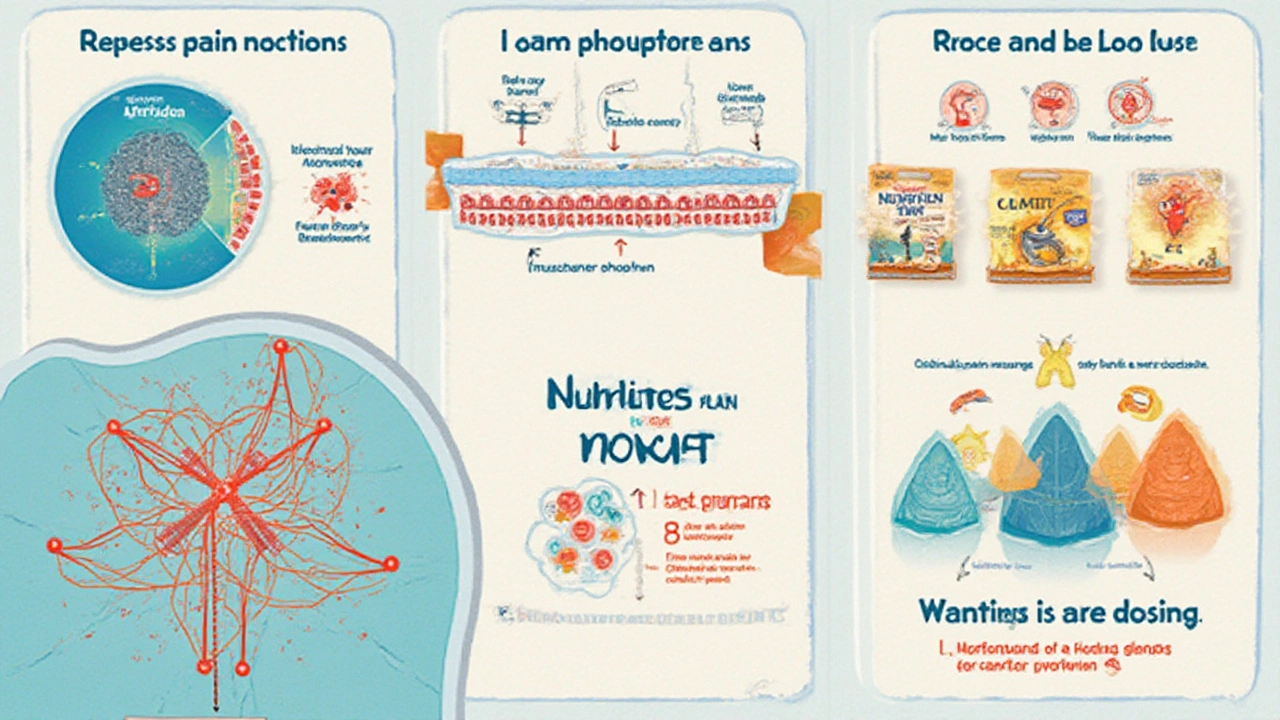Ever notice how everyone acts like popping a Nurofen fixes almost any ache, whether it's a dull headache from bad sleep or that stubborn back pain that just won’t let up? At this point, Nurofen is practically a household name across the UK, Australia, and a ton of other places. Yet, people rarely stop and think about what makes this pill tick, why you shouldn’t just reach for it out of habit, and why so many get the basic stuff wrong about when and how to use it. Some trust it blindly, others worry it’ll destroy their stomach—but both sides usually miss some key facts.
What Exactly Is Nurofen and How Does It Work?
Let’s clear up the basics. Nurofen is not some mysterious miracle. It’s actually just a brand for ibuprofen, a non-steroidal anti-inflammatory drug (NSAID). Pfizer invented ibuprofen way back in the early 1960s, initially hoping it might treat arthritis. These days, it’s your trusty headache helper and period pain pal, but it does a lot more under the hood than you might guess.
Ibuprofen works by blocking enzymes called COX-1 and COX-2. In plain English? Those enzymes are involved in making prostaglandins, which are basically little messengers that tell your brain you’re in pain or something is swollen. Nurofen turns down the volume on those messages, so you feel better—at least for a while.
But did you know Nurofen doesn’t just help with pain? It also reduces inflammation (think: sprained ankles, sore joints) and brings down fevers. That’s why one small tablet can have so many uses.
People often claim Nurofen kicks in faster than paracetamol, and in some situations, that's true. While it usually starts working within 20–30 minutes, full relief may wait up to 2 hours, depending on the reason you took it and whether you swallowed it with food or on an empty stomach.
The wide range of Nurofen products adds another twist. There are regular tablets, liquid capsules (called “Nurofen Express”), gels, and even syrups for kids. Liquid capsules can absorb a bit faster, especially useful for migraine sufferers who want quick results. And yes—Nurofen gel actually goes through the skin right to sore muscles, though it doesn’t work as well for deep joint pain as the pills do.
| Type of Nurofen | Best For | Typical Onset |
|---|---|---|
| Regular Tablets | General pain, fever, inflammation | 20–45 min |
| Liquid Capsules (Express) | Fast migraine relief, toothache | 10–30 min |
| Topical Gel | Muscle sprain, minor sports injury | Local relief, 30–60 min |
| Syrup (Children) | Fever, teething pain | 20–40 min |
The next time someone asks why Nurofen works for their period cramps or if it’s different from Advil or Motrin—they’re all ibuprofen, just with different names and sometimes a slightly different coating or speed of release.

How to Use Nurofen Safely and What to Watch Out For
Just because you can snag Nurofen off any pharmacy shelf doesn’t mean there’s zero risk. Actually, plenty of people accidentally mess up dosing, which puts them at risk for side effects they don’t see coming until it’s too late. For healthy adults, the safe max is 400 mg per dose, every 4–6 hours, with a daily ceiling at 1,200 mg unless otherwise told by a doctor. Kids? Way less—dosing depends on their weight, not just age.
Here’s something wild: surveys in the UK suggest about 1 in 7 people have taken more than the recommended dose at least once, either chasing faster relief or just forgetting when they last popped a pill.
- Never take Nurofen on an empty stomach if you have a sensitive gut. It can irritate your stomach lining—some call this the “NSAID ache”—and over time, repeated use can literally wear a hole through it, leading to ulcers or, in rare cases, bleeding. Don’t brush this off: hospital admissions for NSAID-induced ulcers are higher than those for complications from acid reflux medications.
- Don’t combine Nurofen with other NSAIDs like aspirin or naproxen, unless a healthcare professional gives you a very good reason. That stacks up risk without adding much extra pain relief.
- People with asthma should double-check with their doctor, because NSAIDs can sometimes trigger serious breathing issues.
- If you have or have ever had kidney problems, steer clear or use Nurofen only under strict supervision. Ibuprofen messes with blood flow to the kidneys—bad news if they’re not in top shape to begin with.
- If you’re pregnant or breast-feeding, it gets tricky. Most guidelines advise against ibuprofen in late pregnancy, since it can affect fetal blood flow. Paracetamol is usually considered safer.
Remember all those horror stories about NSAIDs wrecking your heart? It's true, but the risk mostly appears with high doses or long-term use. The occasional Nurofen for a killer headache probably won’t hurt your ticker. Still, if you’ve had a stroke, heart attack, or heart failure before, or you’ve got high blood pressure, talk to your doc before you touch any NSAID at all.
| Tip | Why It Matters |
|---|---|
| Drink water with every dose | Prevents stomach irritation |
| Track every dose—set phone reminders if needed | Avoids accidental overdoses or dose-doubling |
| Read the leaflet, even if you think you know it all | Some brands have added ingredients (caffeine, codeine) |
| Never mix with alcohol | Alcohol amplifies stomach and kidney risks |
| Don’t use for more than 3 days for pain or 3 days for fever unless advised | Avoids masking serious issues |
A few more pro tips? If you find you need Nurofen every week just to function, don’t tough it out. Chronic pain needs a proper check-up, not just a Band-Aid in pill form. And look out for Nurofen products “plus” or “extra”—they sometimes pack other drugs, like codeine, which isn’t safe for regular use and can be addictive.

What People Get Wrong—and Surprising Uses and Limitations
Here’s a common mistake: thinking Nurofen is always the best choice for pain. Ibuprofen is great for pains caused by inflammation—period cramps, sprained ankles, tension headaches. But for most toothaches or fever in kids, paracetamol sometimes works just as well and has a gentler side effect profile, meaning fewer tummy aches.
A weird fact? Ibuprofen can make chickenpox way worse. Kids with chickenpox who take it have a higher risk of developing nasty skin infections. The UK’s NHS warns against using Nurofen for chickenpox for this exact reason. Not many parents know this, so next time chickenpox hits, reach for paracetamol instead.
Sports types sometimes overuse Nurofen, swallowing pills before and after workouts to “ward off” soreness. But a study out of Stanford showed athletes who do this regularly end up with more gut issues and, weirdly, no real gain in performance or recovery time. Pain is your body’s alarm system—don’t switch it off just for bragging rights.
One tricky area is mixing Nurofen with alcohol. People might shrug it off because they didn’t notice anything bad after a night out, but the data is clear: the combo can double your risk for stomach bleeds. And if you take Nurofen on an empty stomach, the risk goes up even more. It’s not just older adults at risk—young people can get into trouble, too.
For those who have arthritis, Nurofen works, but only up to a point. Yes, it cools down inflammation and helps stiff joints feel less wooden. But scientists warn that masking ongoing pain with Nurofen alone just hides the problem, rather than tackling the underlying cause. For chronic conditions, doctors often pair it with other medications or suggest therapies like physical rehab, which do more in the long run than just popping pills.
Let’s set the record straight: Nurofen isn’t addictive in the way opioids like codeine are, but people can fall into the habit of using it too much, which brings them right back to the risks—ulcers, kidney issues, and more. It also doesn’t “cure” anything—if you’re taking it to mask nonstop pain, something bigger may be going on.
Here’s a myth that needs smashing: higher doses don’t mean stronger relief. Some assume that taking 800 mg will bulldoze the pain faster, but studies show that above the standard dose, you only get a small boost in pain relief, and the chance of stomach or kidney trouble jumps sharply. Always use the lowest dose for the shortest possible time—that’s the golden rule.
If you’re ever uncertain, double-check with a doctor before mixing Nurofen with any prescription medicine, especially blood pressure tablets, blood thinners, or antidepressants. Ibuprofen can make some drugs less effective, and with blood thinners, the risk of bleeding rises fast.
To sum it up, Nurofen works well for lots of everyday aches, but it’s not magic or risk-free. Know what it’s really for, protect your gut and kidneys, and don’t take more hoping for miracles. Handled wisely, it’s a solid option—just not a cure-all. Next time someone at work says they take four at once “just to get through the day,” you’ll know how strangely common, and risky, that shortcut really is. And even though it can seem like a friendly staple in the medicine cabinet, respecting the limits of Nurofen is always the smarter move for lasting relief.


12 Comments
July 10, 2025 Darla Sudheer
Nurofen works fast because it blocks the pain signals. Taking it with a little food helps protect your stomach.
July 19, 2025 Elizabeth González
Indeed, ibuprofen’s inhibition of COX enzymes reduces both nociception and inflammation, which explains its versatility across diverse pain etiologies. Nevertheless, clinicians emphasize adherence to dosing limits to mitigate gastrointestinal and renal adverse events.
July 29, 2025 chioma uche
Stop letting foreign drug companies dictate how we manage pain; we deserve safer alternatives that respect our bodies! The current reliance on a single NSAID shows how vulnerable we have become to imported pharmaceuticals.
August 7, 2025 Satyabhan Singh
While the sentiment of self‑reliance is commendable, the pharmacological profile of ibuprofen remains universally derived from rigorous scientific inquiry rather than geopolitical origin. Consequently, prescribing practices should remain evidence‑based, irrespective of national provenance.
August 16, 2025 Keith Laser
Oh great, another reminder that popping a pill is the pinnacle of personal achievement-why not add a medal while you’re at it?
August 25, 2025 Winnie Chan
Sure, because nothing says ‘I’m handling adulthood’ like a handful of tablets, right?
September 4, 2025 Kyle Rensmeyer
People think Nurofen is harmless but big pharma hides the long term kidney damage you’ll see later 🙂
September 13, 2025 Rod Maine
Bruh stop overusing Nurofen.
September 22, 2025 Othilie Kaestner
Honestly, if you’re relying on Nurofen every week you’re just masking the real problem, not fixing it.
October 1, 2025 Sebastian Samuel
🤔💊 Maybe try some stretches before you reach for the bottle? 🏃♂️🚫
October 11, 2025 Mitchell Awisus
When it comes to over‑the‑counter analgesics, ibuprofen remains a cornerstone, yet its widespread availability often masks a series of nuanced considerations,
first and foremost the dose‑response relationship, which indicates that increasing the milligram count beyond the recommended 400 mg per dose yields only marginal gains in analgesia, while simultaneously amplifying the risk of gastrointestinal erosions, renal insufficiency, and cardiovascular events,
second, the pharmacokinetic profile varies with food intake; a fed stomach slows absorption, delaying peak plasma concentrations, which can be advantageous for those with sensitive mucosa but may be perceived as slower relief,
third, individual patient factors such as age, comorbidities, and concurrent medications must be weighed, because NSAIDs can potentiate the anticoagulant effects of warfarin and similar agents, fourth, the formulation-tablet versus liquid capsule versus topical gel-affects onset time, with liquid capsules often achieving therapeutic levels within ten to twenty minutes, fifth, the chronic use of ibuprofen for conditions like osteoarthritis should be complemented by non‑pharmacologic strategies, such as physiotherapy, weight management, and exercise, sixth, pediatric dosing is weight‑based, not age‑based, and errors in this calculation are a common source of accidental overdose, seventh, patients with a history of asthma may experience exacerbations triggered by NSAID intake, a phenomenon known as aspirin‑exacerbated respiratory disease, eighth, alcohol consumption interacts synergistically with ibuprofen to increase mucosal injury, a risk that is often underestimated by young adults, ninth, the regulatory landscape differs internationally; for instance, the maximum daily dose in the United Kingdom is 1,200 mg, whereas in the United States it may be higher under certain circumstances, tenth, education on reading the drug label is essential, because some branded products contain additional active ingredients like codeine, which carry their own dependency risks, finally, the overarching principle remains to use the lowest effective dose for the shortest duration necessary, a guideline that aligns with both clinical safety and public health stewardship, any deviation from these recommendations should prompt a conversation with a healthcare professional, who can assess the risk‑benefit profile tailored to the individual, in summary, while ibuprofen is an effective tool in the analgesic arsenal, responsible use hinges on informed decision‑making, vigilant monitoring, and a willingness to explore adjunctive therapies beyond the pill.
October 18, 2025 Annette Smith
That’s a good reminder, keep it simple and safe.
Write a comment